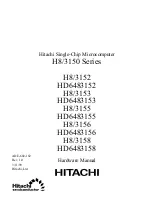
EMBEDDED Intel486™ PROCESSOR HARDWARE REFERENCE MANUAL
4-14
Figure 4-9
shows more than one primary bus master and two secondary masters, and the arbitra-
tion logic is more complex. The arbitration logic resolves bus contention by ensuring that all de-
vice requests are serviced one at a time using either a fixed or a rotating scheme. The arbitration
logic then passes information to the Intel486 processor, which ultimately releases the bus. The
arbitration logic receives bus control status information via the HOLD and HLDA signals and re-
lays it to the requesting devices.
Figure 4-9. Single Intel486™ Processor with Multiple Secondary Masters
As systems become more complex and include multiple bus masters, hardware must be added to
arbitrate and assign the management of bus time to each master. The second master may be a
DMA controller that requires bus time to perform memory transfers or it may be a second pro-
cessor that requires the bus to perform memory or I/O cycles. Any of these devices may act as a
bus master. The arbitration logic must assign only one bus master at a time so that there is no con-
tention between devices when accessing main memory.
Intel486™
Processor
DMA
MEM
I/O
Arbitration
Logic
ACQ
ACK
HLDA 0
HOLD 0
DRQ
DACK
Address Bus
Data Bus
Control Bus
BDCK
BREQ
Summary of Contents for Embedded Intel486
Page 16: ......
Page 18: ......
Page 26: ......
Page 28: ......
Page 42: ......
Page 44: ......
Page 62: ......
Page 64: ......
Page 138: ......
Page 140: ......
Page 148: ......
Page 150: ......
Page 170: ......
Page 172: ......
Page 226: ......
Page 228: ......
Page 264: ......
Page 282: ......
Page 284: ......















































